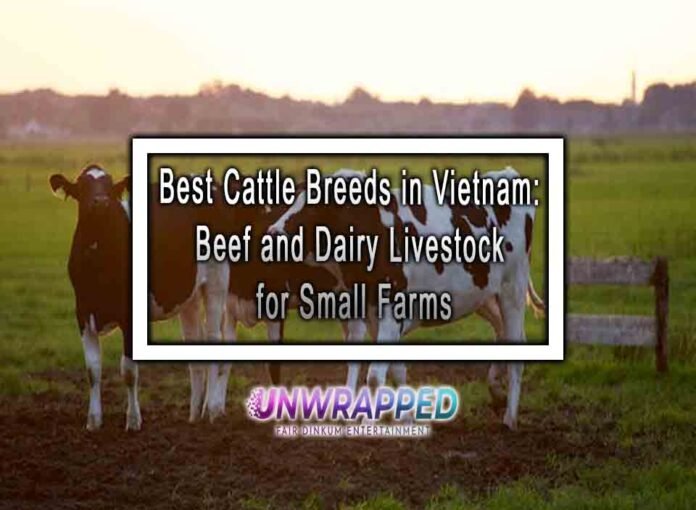Vietnam’s agricultural economy heavily relies on livestock farming, with cattle playing a significant role in providing meat, milk, and draft power for small farms. The country’s diverse geography and tropical climate require cattle breeds that are resilient, adaptable, and productive. From indigenous breeds to imported high-performance cattle, Vietnam’s farmers maximize resources to sustain their livelihoods.
This article explores the best cattle breeds in Vietnam, their characteristics, and their contributions to the success of small-scale farming.
Best Cattle Breeds in Vietnam
1. Yellow Cattle (Vietnamese Native Cattle)
- Key Characteristics: Small frame, yellowish-brown coat, and hardy nature.
- Primary Use: Beef production and draft power.
- Fun Fact: Native to Vietnam, Yellow cattle are resilient to harsh conditions and are ideal for small-scale farmers who rely on natural grazing and minimal resources.
2. Red Sindhi
- Key Characteristics: Red coat, medium size, and excellent heat tolerance.
- Primary Use: Dairy production and crossbreeding.
- Fun Fact: Imported from South Asia, Red Sindhi cattle are known for their high butterfat milk and adaptability to Vietnam’s tropical climate.
3. Brahman
- Key Characteristics: Light gray or red coat, large hump, and loose skin.
- Primary Use: Beef production and crossbreeding.
- Fun Fact: Brahman cattle are highly heat-tolerant and disease-resistant, making them a popular choice for Vietnamese farmers in hot, humid regions.
4. Holstein Friesian
- Key Characteristics: Black-and-white coat, large size, and high milk production.
- Primary Use: Dairy production.
- Fun Fact: Holstein Friesians are widely used in Vietnam’s growing dairy sector, especially in cooler, mountainous regions, where their milk is essential for producing yogurt and condensed milk.
5. Lai Sind (Crossbred Cattle)
- Key Characteristics: Medium frame, variable coat color, and good productivity.
- Primary Use: Dual-purpose (dairy and beef).
- Fun Fact: Lai Sind cattle are a crossbreed of Red Sindhi and native Vietnamese cattle, combining resilience and productivity, making them ideal for small farms.
6. Charolais
- Key Characteristics: White or cream-colored coat, muscular build, and high growth rates.
- Primary Use: Beef production.
- Fun Fact: Charolais cattle are valued in Vietnam for their ability to produce lean, tender beef, catering to the country’s growing demand for premium meat.
7. Jersey
- Key Characteristics: Light brown coat, small frame, and rich milk production.
- Primary Use: Dairy production.
- Fun Fact: Jersey cows are popular in Vietnam for their creamy, butterfat-rich milk, which is perfect for artisanal dairy products.
8. Simmental
- Key Characteristics: Red-and-white coat, large frame, and dual-purpose adaptability.
- Primary Use: Beef and dairy production.
- Fun Fact: Simmental cattle are frequently crossbred in Vietnam to improve milk yields and beef quality while maintaining adaptability.
9. Angus
- Key Characteristics: Black or red coat, medium size, and excellent marbling in meat.
- Primary Use: Beef production.
- Fun Fact: Angus cattle are increasingly favored in Vietnam for producing high-quality beef that meets the demands of both domestic and export markets.
10. Local Hybrid Breeds
- Key Characteristics: Varying coat colors, medium size, and resilience.
- Primary Use: Beef and dairy production.
- Fun Fact: Vietnamese farmers often crossbreed native cattle with imported breeds like Brahman and Holstein to improve productivity while retaining resilience to local conditions.
Sustainability in Cattle Farming in Vietnam
- Small-Scale Farming: Most cattle farming in Vietnam is done on small family farms, using integrated systems where livestock support crop production.
- Rotational Grazing: Farmers practice rotational grazing to maintain soil health and reduce overgrazing in limited pasture areas.
- Crossbreeding Programs: Vietnam emphasizes crossbreeding to develop cattle that can thrive in tropical climates while increasing milk and meat production.
- Sustainable Feed: Cattle are often fed agricultural byproducts like rice straw and cassava leaves, reducing waste and reliance on imported feed.
Interesting Facts About Cattle Farming in Vietnam
- Dairy Growth: Vietnam’s dairy industry is rapidly expanding, with breeds like Holstein Friesians playing a pivotal role in meeting domestic milk demand.
- Integrated Systems: Many Vietnamese farms integrate cattle with rice farming, where cattle provide draft power, manure for fertilizer, and additional income through meat and milk.
- Export Markets: Beef production is gradually increasing in Vietnam, with breeds like Angus and Charolais being raised for export-quality meat.
Frequently Asked Questions
Q: Which cattle breed is best for small farms in Vietnam?
A: Yellow cattle and Lai Sind are ideal for small farms due to their hardiness and adaptability to low-input farming systems.
Q: What is the most popular dairy breed in Vietnam?
A: Holstein Friesians dominate the dairy sector, while Jersey and Red Sindhi are also favored for their rich, high-fat milk.
Q: How do Vietnamese farmers manage cattle in tropical climates?
A: Farmers use heat-tolerant breeds like Brahman and Red Sindhi, crossbreeding them with local cattle to improve productivity while maintaining resilience.
Q: Are there indigenous cattle breeds in Vietnam?
A: Yes, Yellow cattle are native to Vietnam and are integral to small-scale farming, offering meat, draft power, and income.
Conclusion: Resilience Meets Productivity
Cattle farming in Vietnam is an essential part of the country’s agricultural landscape, supporting small farms and contributing to food security. From the hardy Yellow cattle and adaptable Lai Sind to high-performance breeds like Holstein Friesians and Charolais, these cattle reflect the balance between tradition and innovation.
As Vietnam continues to modernize its livestock sector, these breeds will play a pivotal role in ensuring sustainable and profitable farming practices for generations to come.
See Also: Top Cattle Breeds in Bangladesh: Livestock for Dairy and Agricultural Support










